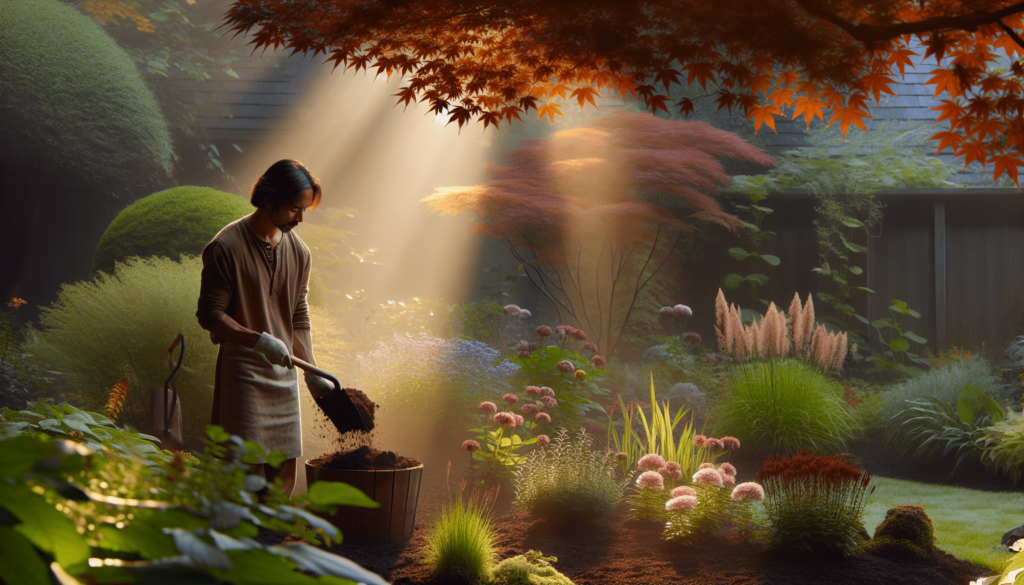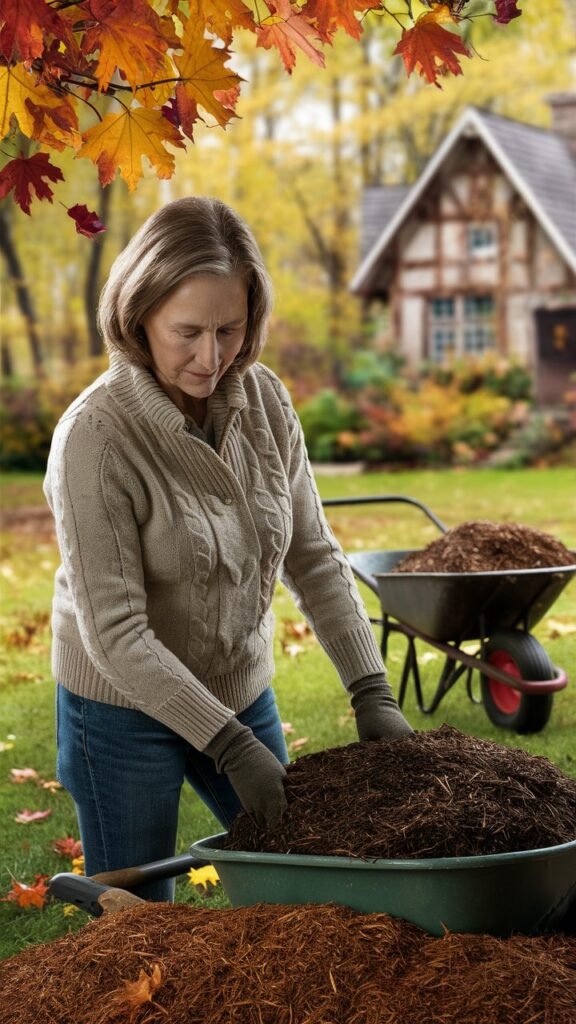Have you ever found yourself wishing for a peaceful retreat amidst the chaos of daily life? Imagine finding peace between the fallen leaves inside your very own backyard, with fallen leaves crunching underfoot and a gentle breeze rustling through the trees. At first glance, autumn’s arrival might seem like nothing more than a chore-filled season, but what if it could become an opportunity to practice mindfulness? That’s where the concept of “Mindful Mulching” comes into play.
Understanding Mindful Mulching
Mindful mulching isn’t just about covering your garden beds with organic material; it’s a way to connect deeply with nature and find tranquility in routine tasks. It’s about transforming the mundane into a meditative practice. By focusing on the present moment while you prepare your garden for winter, you’re not only nourishing your plants but also your soul.
What is Mulching?
Mulching involves placing a layer of material—such as leaves, bark, or compost—over the soil. This process serves several purposes, such as conserving moisture, improving soil health, and reducing weed growth. By adding a mindful approach, you’re enriching not only your garden but your mental well-being, too.
The Benefits of Mulching
Mulching provides a myriad of benefits:
| Benefit | Explanation |
|---|---|
| Moisture Retention | Helps soil retain water, reducing the need for frequent watering. |
| Soil Temperature | Regulates soil temperature, keeping it cooler in summer and warmer in winter. |
| Weed Suppression | Inhibits weed germination and growth, saving you time and effort. |
| Nutrient Addition | Organic mulch breaks down over time, enriching the soil with nutrients. |
| Erosion Prevention | Protects soil from being washed away by rain. |
| Aesthetic Appeal | Adds a finished look to your garden, enhancing its overall appearance. |
By understanding these benefits, you can better appreciate the practical and philosophical value of mulching.
Steps for Mindful Mulching
Practicing mindful mulching involves more than just scattering leaves across the ground. It’s a deliberate process that requires your full attention and intention.
Step 1: Gathering Materials
First, gather your mulching materials. Autumn leaves are readily available and excellent for mulching. As you collect the leaves, pay attention to their colors, shapes, and textures. Notice the crispness when you step on them and the way they rustle in the breeze. Be fully present in this simple act of gathering.
Step 2: Preparing the Ground
Before you lay down the mulch, prepare the ground by removing any weeds or debris. As you work, focus on the sensations in your body—the feel of the soil, the smell of the earth, the sound of the wind. Let these sensory experiences ground you in the present moment.
Step 3: Applying the Mulch
When you begin to spread the mulch, do so with intention. Feel the weight of the leaves in your hands and the motion of your body as you distribute them evenly. Think about each layer providing warmth and protection to the plants during the cold months ahead. Imagine the mulch as a cozy blanket for your garden.
Step 4: Reflecting on the Process
After you’ve finished mulching, take a moment to reflect on the process. What did you notice about the leaves, the soil, and your own movements? How did it feel to be fully present during this task? Recognizing these reflections can deepen your sense of connection and accomplishment to your garden and to yourself.

Mulching Materials: Choosing the Right One
Selecting the right mulching material is integral to the success of your mindful mulching practice. Different materials offer different benefits, so consider what’s most suitable for your garden’s needs.
Organic vs. Inorganic Mulch
Organic materials like leaves, straw, and compost not only protect and enhance the soil but also break down to add nutrients. Inorganic mulches like stones or landscape fabrics don’t decompose and therefore don’t contribute to soil health but are excellent for durability and certain aesthetic considerations.
| Type | Examples | Benefits |
|---|---|---|
| Organic | Leaves, straw, bark | Enhances soil health, adds nutrients, biodegrades over time. |
| Inorganic | Gravel, plastic, rubber | Low maintenance, long-lasting, ideal for landscaping. |
By choosing the right mulch, you’re ensuring that both your garden thrives and that your efforts are rewarded.
Practical Tips for Effective Mulching
While mindfulness is at the heart of this practice, it’s important to follow practical guidelines to ensure your efforts yield the best results.
Timing Your Mulch Application
Timing is crucial. Apply mulch in late fall when the soil has cooled but not frozen. This helps to regulate soil temperature and moisture throughout the winter.
Mulch Thickness
Ensure your mulch layer is neither too thick nor too thin. A 2- to 3-inch layer is generally sufficient. Too much mulch can suffocate plant roots, while too little won’t offer adequate protection.
| Thickness | Benefit # |
|---|---|
| 2-3 inches | Adequate protection and nourishment, prevents weed growth. |
| >3 inches | Risk of root suffocation and poor air circulation. |
| <2 inches | Insufficient protection, higher risk of weed germination. |
Avoiding Mulch Volcanoes
Avoid piling mulch against the trunks of trees and plants, often referred to as “mulch volcanoes.” This practice can lead to rot and pest infestation. Instead, leave a couple of inches around plant stems to allow air circulation.

The Philosophical Side of Mindful Mulching
Mindful mulching isn’t just a gardening technique; it’s a form of meditation and self-care. Engaging in this practice allows you to slow down and appreciate the simple pleasures of life.
Embracing the Cycle of Nature
Autumn is a time of transformation. Leaves fall, trees prepare for dormancy, and the garden quiets down. Mindful mulching encourages you to embrace these natural cycles, acknowledging that decay and growth are interconnected processes.
Cultivating Patience and Presence
Gardening is an exercise in patience. Plants grow in their own time, and trying to rush them is futile. By attending to each step of the mulching process with care and attention, you cultivate a kind of patience that can extend into other areas of your life.
Finding Joy in Simplicity
There’s a unique joy in simple, hands-on tasks that engage your senses and quiet your mind. The act of mulching might be repetitive, but in its very repetition lies the potential for mindfulness and serenity.

Tips for Maintaining a Mindful Garden
Once you’ve adopted mindful mulching, consider applying these principles to other gardening tasks.
Regular Weeding
Instead of viewing weeding as a burden, see it as another opportunity to connect with your garden. Feel the soil between your fingers and appreciate the satisfying sensation of pulling out weeds by the roots.
Planting with Intention
When you plant new seeds or bulbs, do so with intention. Think about the life you’re nurturing and visualize the plants growing strong and healthy.
Seasonal Observances
Mark the changes of the seasons with small rituals. Celebrate the first blooms of spring, the bounty of summer harvests, the vibrant colors of fall, and the quiet beauty of a winter garden.
Sustainable Gardening Practices
Mindful mulching aligns beautifully with sustainable gardening practices. By choosing natural, biodegradable materials, you’re reducing waste and promoting a healthier ecosystem.
Composting
Rather than disposing of leaves, branches, and other organic waste, turn them into compost. Composting not only enriches your soil but also reduces your environmental footprint.
Water Conservation
Use mulch to conserve water by reducing evaporation from the soil surface. This is particularly important in areas prone to drought. By conserving water, you’re being more mindful of your resource usage.
Supporting Biodiversity
A garden that’s mulched with organic materials can support a variety of beneficial insects and microorganisms. These tiny allies help break down the mulch and contribute to a healthier garden ecosystem.
- Made with dye-free, sustainable wood (recycled green waste inputs, including diverted scrap wood from lumber processes)
- Our organic mulch helps with the prevention of weeds (a 3 inch layer naturally prevents weeds by blocking growth and acc…
- This mulch is safe to use around kids and pets (when used as directed; this product never uses construction debris or pa…
- 100% Natural Cedar; Use with your outdoor and indoor plants; will hold moisture in! 4 Quart; Natural product so cedar sh…
- Use as an air freshener; natural subtle cedar scent; Refill your cedar sachet bags; Made in USA
- Put in animal bedding; Put in kitty litter; absorbs smelly odors

Creating a Mindful Garden Routine
Incorporating mindful practices into your gardening routine can transform it from a list of chores into a meditative experience.
Morning Garden Walks
Start your day with a peaceful walk through your garden. Notice the changes that have occurred overnight, be it new blooms or the presence of dew on the leaves.
Mindful Watering
When you water your garden, focus on the sensation of the water flowing and the way the plants respond. Notice the droplets on their leaves and the way the soil absorbs moisture.
Seasonal Reflections
At the end of each season, take some time to reflect on the growth and changes in your garden. What worked well? What could you do differently next season? This reflection can deepen your connection to your garden and help you become a more mindful gardener.
Conclusion
Mindful mulching offers a serene, enriching way to prepare your garden for winter while fostering a deep connection with nature and yourself. By paying attention to each step, you transform a simple task into an act of meditation and self-care. As the leaves fall and the world quiets, let your garden be a place of peace and mindfulness. Embrace the cycles of nature, savor the simple joys, and cultivate a sense of presence that extends beyond your garden and into your everyday life.

My name is Michelle Warren, and I’m the founder of Peaceful Gardening. As a 10-year breast cancer survivor, I’ve discovered the profound therapeutic power of gardening. This journey has not only helped me recover but has also become my passion and a source of ongoing peace and joy.
Peaceful Gardening was born from my desire to share the healing benefits of gardening with others. Whether you’re facing health challenges, dealing with stress, or simply looking to connect more deeply with nature, this space is for you.
Over the past decade, I’ve cultivated not just plants, but a deep understanding of how gardening can positively impact mental health. I’ve worked with local community gardens, led workshops on mindful gardening practices, and collaborated with mental health professionals to develop gardening-based stress reduction programs.
Peaceful Gardening was born from my desire to share the healing benefits of gardening with others. Whether you’re facing health challenges, dealing with stress, or simply looking to connect more deeply with nature, this space is for you.
Here, you’ll find evidence-based advice on using gardening as a tool for mindfulness, stress relief, and emotional healing. I share personal stories, practical tips, and scientifically-backed information on how to create your own therapeutic garden space, no matter the size of your yard or balcony.
My mission is to help you discover the joy, peace, and healing that comes from nurturing plants and connecting with nature. Join me in exploring how the simple act of tending to a garden can transform your mental and emotional wellbeing.
Welcome to Peaceful Gardening – let’s grow together towards better mental health!”


